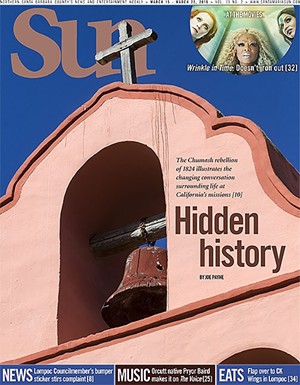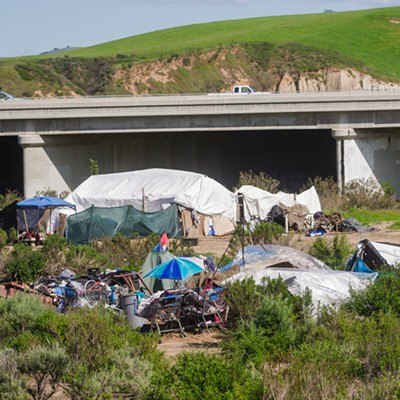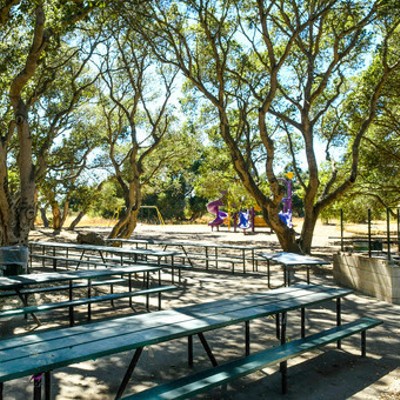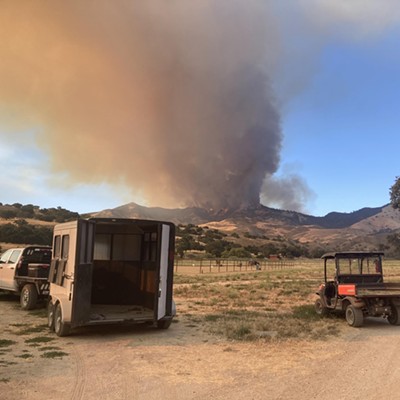View a slideshow from La Purisima Mission.
The salmon-hued tower of Mission La Purisima looms over the pastoral grounds near Lompoc where generations of California fourth-graders field trip each year to learn about the state’s mission era and the people who called Purisima home centuries ago.
But life at the mission wasn’t always so serene. Forced hard labor, deadly outbreaks of disease, and the prohibition of native languages were the reality for the Chumash Indians who lived there.
For anyone who visits La Purisima on March 16, the day marks the anniversary of a bloody battle. Cannonballs and musket fire rained over the sanctuary of the mission. In 1824, the Chumash at missions Santa Ines, Santa Barbara, and La Purisima rose up against the Mexican military forces that commanded the missions, holding Purisima for weeks before a battalion of more than 100 soldiers came to reclaim it. The conflict ended with at least 16 Chumash killed.
That history is a far cry from the candle making and blanket weaving often demonstrated at the La Purisima Mission State Historic Park’s “life days” events and what’s been taught during decades of fourth grade mission projects.
Until now.
The California Department of Education adopted a new framework for social studies curriculum that begins this year, including changes to the fourth grade mission project. According to the framework, “teachers should focus on the daily experience of missions rather than on the building structures themselves.”
Foregoing the sugar cube or foam board models of a chosen mission upset some parents, La Purisima State Park Interpreter Ann Boggess told the Sun.
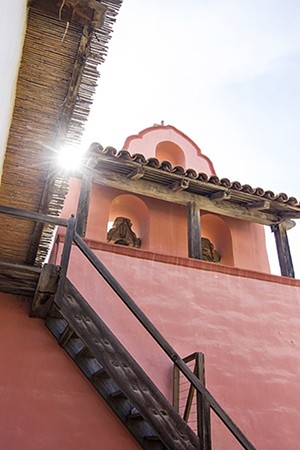
“Everybody thinks, ‘No more missions?’ But that’s not what they said,” Boggess explained. “They wanted to increase the diversity and the richness of the story of the missions.”
The approach to history at the state park has changed over the years as well, Boggess said. The popular “life days” that include docents dressed in period attire demonstrating crafts no longer see the re-enactors pretending to be the Chumash who lived there, she said.
“We’re trying to wrangle in some of the stuff here that were inappropriate,” she said. “Whatever we put out right now, we’re trying to make quality.”
The Chumash rebellion in 1824 provides a unique snapshot of the collision of cultures at the missions, as well as a deeper look into the ongoing issues that stoked the conflict. It’s a perfect teaching tool to help uncover a complex period of change in California and its peoples’ history.
For Ernestine Ygnacio-De Soto, a direct descendant of the Barbareño Chumash whose great-grandmother lived through the rebellion, it illustrates a peaceful people pushed to their limit.
“We were not warlike people,” she said. “We had our own little skirmishes among one another like you do among your family, but we were not out slaughtering. It was kind of like, this is the last straw that broke the camel’s back.”
Powder keg in paradise
The most direct cause of the uprising was an incident that happened on Feb. 21, 1824, at Mission Santa Ines, according to John Johnson, curator of anthropology at the Santa Barbara Natural History Museum. All the primary sources said that a Chumash man from La Purisma was visiting Santa Ines to see an imprisoned relative, and for reasons that aren’t totally clear, he was severely beaten by a soldier named Valentín Cota. Before the day was over, parts of the mission went up in flames, a handful of soldiers and Chumash were dead, and revolution was already stirring at the two nearby missions.
But to really understand why that incident was the “last straw,” Johnson said you need to understand the conditions that led up to it.
The Chumash had suffered years of declining population and high infant mortality due to European-introduced diseases. On top of that, he said, there was a years-long drought that was taxing food stores across Alta California. Mexico’s revolution for independence against Spain also put the missions under the charge of Mexican soldiers alongside the Spanish missionaries, who relied on the Chumash as their agricultural workforce.
“The burden of feeding people fell on the missions, and with declining populations, a lot of pressure went on the backs of the Indians,” Johnson said. “I think those are some of the factors.”
That pressure on the Chumash was in direct conflict with Mexico’s new secular Constitution, which granted full and equal rights to natives. The Chumash living at the missions weren’t granted that luxury.
“They had grown up under the mission system at that point, and they were probably chafing for independence,” Johnson said. “They didn’t see that much different between themselves and the soldiers: Why should they be free and independent while the Indians were under the authority of the missionaries, when the whole idea of the missions in the first place was to acculturate the natives so they would become good citizens of Spain, or Mexico later on, but when is that going to happen?”
Johnson teaches history classes on California Indian history at UC Santa Barbara and has taught summer institutes for teachers that include interpretation of the rebellion. The uprising, he said, provides a keen illustration of the turbulent times.
There are “oral history accounts, actual interrogation accounts, accounts by military, accounts by missionaries,” he said. But the Chumash’s direct experiences are missing from the record. Missionaries and soldiers testified on their behalf.
The Chumash side of the story isn’t told until almost a century later from interviews by the anthropologist John P. Harrington of Santa Ynez and Santa Barbara Chumash, Johnson explained. Those accounts were from Chumash who grew up hearing stories of the uprising, and they cast blame on an interpreter between the Chumash and Mexican soldiers.

All of the accounts conflict somewhat. Johnson compared it to the Akira Kurosawa film Rashomon, in which three accounts of an incident all differ based on who’s telling them.
That’s part of what makes the rebellion such a vital subject for teaching California history—peoples and cultures collide, conflict foments, and everyone has their side of the story, Johnson explained.
“I end the mission period with discussion of the revolt,” he said. “You have the missionaries blaming the soldiers, the soldiers blaming the Indians, and the Indians blaming a particular Indian interpreter that they say misinterpreted them. So they all had different points of view on this.”
The new state guidelines for fourth grade teachers do more than frown on sugar-cube models, but ask to teachers to explore the complex and sometimes harsh realities of the history.
“Some mission Indians sought to escape the system by fleeing from the padres, while a few Indians openly revolted and killed missionaries,” the guideline reads. “Sensitizing students to the various ways in which Indians exhibited agency in the mission system provides a more comprehensive view of the era for students.”
‘What are we to do?’
While the uprisings at Santa Ines and La Purisima ended with bloodshed and dead Chumash and Mexican soldiers, Santa Barbara was a different story.
The Chumash there took the mission from the soldiers after they got word of the uprising at Santa Ines. According to a letter penned by Father Antonio Ripoll, the head priest at Mission Santa Barbara at the time, the Chumash expelled the soldiers at the mission and forcefully took their guns, only leaving a couple of cuts on the hands of two soldiers.
“It is to be noted that neither to the padre nor to the majordomo in charge of the keys did they offer the least insult,” Ripoll wrote on May 5, 1824.

But those soldiers retreated to the Santa Barbara Presidio to collect reinforcements and returned to fight the Chumash. There was a small skirmish when the soldiers arrived, but most of the Chumash had already left the mission, heading for the Santa Ynez Mountains.
Those Chumash walked over the mountains and cross country to escape the soldiers, seeking refuge with the Yokut Indians near modern-day Tulare.
“We took off because we knew they were going to kill us,” Ygnacio-De Soto said. “We weren’t going to stay home and get slaughtered.”
Those fears were well-founded.
Another incident was the murder of four Chumash men who were merely traveling to Mission Santa Barbara to see what had happened. They were shot by Mexican soldiers, including one Indian who climbed a tree and begged for his life, according to Ripoll’s account.
“With that they shot him dead. Great bravery, indeed!” Ripoll wrote sarcastically.
Some scholarship on the revolt argues that the Chumash didn’t hold animosity or blame toward the missionaries throughout the conflict, Johnson said. In fact, missionaries like Ripoll advocated for the Chumash, blaming the soldiers for the harsh treatment, and helped broker a pardon after the dust settled.
And according to Ripoll, the natives carried their Catholicism and the skills they learned from mission life with them when they left.
“‘What are we to do at the mission since the soldiers have robbed all of our belongings, seeds, etc.?’” Ripoll quotes a Chumash leader in his letter. “‘We shall maintain ourselves with what God will provide us in the open country. Moreover, we are soldiers, stonemasons, carpenters, etc., and we will provide for ourselves by our work.’”
Many of the Chumash who fled the missions were still devout Catholics, however, and would eventually return to the mission after negotiating peace with the soldiers through the missionaries. Others may have never returned, but instead returned to Chumash cultural norms and beliefs.
Some scholars have argued that the Chumash returned due to demographic pressures, as a people whose numbers were taxed by disease. Others say that the Chumash who fled to Tulare were already reverting back to Chumash cultural practices and shedding Catholic rules of marriage and worship.
For Ygnacio-De Soto, the return represents two things about the Chumash: that they wanted to go back to the “paradise” that they’d called home for so long, and that they were Christianized enough to forgive what they’d suffered. A devout Catholic herself, Ygnacio-De Soto empathized with their decision to come back to a familiar way of life connected to the church.
“People don’t understand, they say, ‘Why are you Catholic?’” she said. “But do you think we were really going to stay here untouched as we were then 200 years ago, seriously speaking?
“I don’t harbor bitterness because I consider God my spoils of war,” she added. “I lost my land, lost my dignity, lost everything. But, I have my Catholicism.”
End of an uprising
Many of the Chumash involved in the rebellion were not content fleeing to the mountains or into the Central Valley.
Instead of abandoning their home, the Chumash of La Purisima decided to stay and hold the mission. They expelled most of the missionaries and all of the soldiers as part of a plan that, according to some, was months in the making.
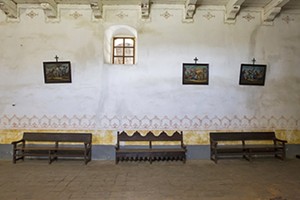
By those accounts, the long-planned uprising was spurred by the beating at Santa Ines. Whether spontaneous or a methodical plot, the Chumash uprising represents the most wide-scale rebellion of Native Americans during the mission era.
“Many of the missions had cases where there were rebels, but not of this scope,” Johnson said. “It is the major rebellion of the mission era.”
According to a 1985 article in the Southern California Quarterly by James Sandos, the Chumash at La Purisima were joined by other Chumash from the missions as well as some allied Yokuts, where they collectively held the mission for more than three weeks. Making up a force of more than 400, the Chumash fortified the sanctuary and grounds for battle, building ramparts and cutting archery slits in the adobe brick.
Many of the Chumash there were involved in building the mission at its current location after the original La Purisima grounds were destroyed by a massive earthquake and subsequent flooding in 1812. One Chumash man named Pacomio was a carpenter who labored at the new mission, Johnson explained, and helped lead the Chumash warriors who captured it.
That the Spanish missionaries built the missions is a common misconception, one addressed by the state’s new social studies guidelines.
“We’re the ones who built it,” Ygnacio-De Soto said. “[The Spanish missionaries] didn’t build it, they were the designers. I’m glad that’s coming into view.”
The garrisoned force of natives waited more than three weeks before a small army of 109 Mexican soldiers, cavalry, and artillery led by Lt. José María Estrada made it to La Purisima on March 16. They had come from the north, leaving Mission San Luis Obispo two days prior.
Each side exchanged musket and cannon fire, but the Mexican soldiers’ skill with the modern weapons prevailed, killing at least 16 Indians while only suffering three casualties, one fatal, before the Chumash surrendered.
As quickly as it had started, the uprising was over.
But good students of history, whether in fourth grade or pursuing graduate degrees, should take note of the years of events and influences that led to the dramatic day, Johnson explained.
“In 1824, that’s more than 40 years after the Presidio was founded and things began to change,” he said. “So four decades had taken place of colonial impacts.”
It also took some time to coax the Chumash who had fled the region back to the missions. Thanks to intercession and negotiation by Spanish missionaries with the then-governor of Alta California, a pardon was issued to the Chumash who fled inland. The rebellion’s leaders, like Pacomio, were tried and sentenced to hard labor. An expedition was sent out that June that included soldiers accompanied by Father Ripoll, who helped negotiate the collective return of the Chumash in Tulare.
It would be more than a decade before the mission era ended and secularization began, but the Chumash weren’t free from hardship after that, Johnson explained. The largest free settlement of Chumash formerly of La Purisima was decimated by disease in 1844, he said.
The remaining Chumash were left to scrape out a living on the land they were given, getting by with the crafts they’d learned while living at the missions.
For La Purisima State Parks Interpreter Boggess, it delineates where the mission story ends and another complex chapter of nuanced state history begins. It’s all a challenge to present accurately and sensitively, she said, both in the classroom and on the mission grounds.
“Teachers have a lot on their plates to try and teach it correctly,” she said. “I’ve been teaching it for 11 years and it’s an incredibly complex story. I can’t give it to you in a nutshell; it doesn’t fit in a cookie cutter. It is so deep and there’s so many people that interact and perspectives that live here, and the tragedy, and things that are better and things that are worse.”
While the more mundane features of life on the missions, like agriculture and carpentry, are easy to present to fourth graders working on their mission projects, the cultural and ethnic conflicts are much more challenging to convey. But that’s exactly what the new state curriculum calls for: an examination of how the mission affected the lives of everyone involved.
“It’s humans living together and trying to survive together in a really broken, challenging system,” Boggess said. “There’s so many undercurrents we don’t even know.”
For Ygnacio-De Soto, the rebellion reveals a truth about her people, from her great-grandmother to her mother and herself.
“It represents the fact that they had it up to their eyeballs and that was the straw that broke the camel’s back,” she said. “I’m the same way. I never lose my temper, but God help you if I do. And if my mother ever lost her temper, you better be across the country.”
Ygnacio-De Soto connects that truth with today’s struggles that she finds important. She’s a regular at public meetings, especially when it concerns petroleum development in Santa Barbara County, which she is staunchly opposed to, adding her voice to the conversation that for so long excluded or ignored the Chumash.
“We’ve pushed Mother Earth to the very edge now, and it’s just the same with that rebellion, it’s the same with my mom, it’s the same with me,” she said. “I’m like that uprising, only on the inside. I let it out wherever I’m at, whenever I’m called to do something.”
Contact Managing Editor Joe Payne at [email protected].


